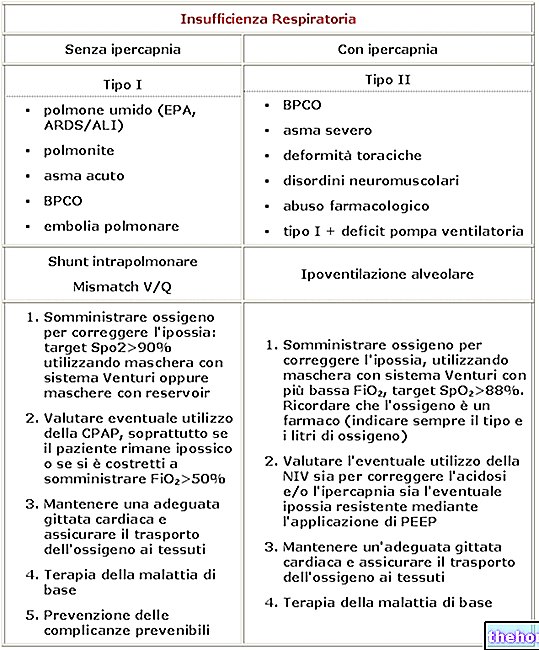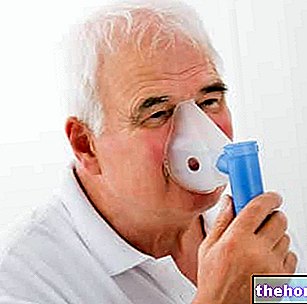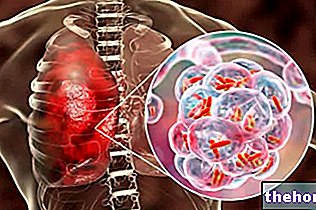Generality
Asthma is a chronic inflammatory disease of the airways characterized by obstruction, generally reversible, of the bronchi.
The obstruction of the bronchial tree is caused by the inflammation of the lower airways and its consequences:
due to the inflammatory process, the bronchi contract, fill with fluid and produce an excess of mucus, reducing overall the spaces available for the free circulation of air.
Consequently, bronchial asthma causes:
- shortness or difficulty in breathing
- cough
- whistling or wheezing breath
- tightness in the chest.

Causes
Bronchial inflammation is often caused by the sensitization of the bronchial tree to particular allergens; in practice, when in contact with certain substances (pollen, pollutants, smoke, etc.) the respiratory tract of an asthmatic subject responds exaggeratedly by becoming inflamed and narrowing.
We speak of bronchial hyper-reactivity precisely because the same stimuli, at the same dose, do not cause significant responses in healthy subjects.
Epidemiology
Asthma is particularly widespread among the population, since it affects on average about 5% of Italians and almost 10% of infants. To these data should then be added all those cases in which the subject is ill without knowing it.
In fact, it can happen that the symptoms of asthma are misinterpreted or underestimated by the patient, especially if they are young; a certain slice of the population thus tends to ignore the typical symptoms of the disease without giving too much weight to the alarm signals sent by the body. .
Symptoms of Asthma
For further information: Asthma Symptoms
When a person suffers from asthma, they experience symptoms such as:
- Irritating cough, more or less persistent, which may appear or accentuate during the night or upon awakening, sometimes associated with a sense of stuffy nose or repeated sneezing
- difficulty in breathing or wheezing (wheezing, shortness of breath)
- the breath is wheezing even if this characteristic is not always perceived by the patient
All these symptoms do not occur at the same time in the same person, nor do they always occur with the same intensity (when they are very intense we also speak of an asthma crisis) and can develop at different times in the course of life.
Finally, we must NEVER forget that even if it does not show signs of itself for long periods, asthma is a chronic disease which, if neglected, undergoes sometimes serious exacerbations.
Importance of Early Diagnosis
In any case, if symptoms such as cough, shortness of breath and wheezing occur, it is necessary to carry out appropriate investigations, since asthma, unfortunately, is certainly not a disease to be taken lightly. It must also be remembered that, even if it mainly affects young people, asthma can occur at any age. In particular, after the age of thirty, this disease mainly affects women, it tends not to have an allergic origin and responds poorly to drug therapy.
The important thing in any case is to diagnose asthma as soon as possible since the treatments exist, are effective and allow the patient to lead an absolutely normal life.
The presence of any of these signs and symptoms should lead to suspicion of asthma:
- Frequent (more than once a month) episodes of wheezing
- Cough or wheezing induced by physical exertion
- Especially nocturnal cough, even outside of respiratory infections
- Absence of a seasonal pattern of symptoms
- Symptoms persist even above 3 years
- Symptoms worsen in the presence of:
- Aeroallergens (house dust, furry animals, cockroaches, fungi)
- physical exercise
- chemical pollutants
- viral respiratory infections
- intense emotions
- smoke
- Symptoms respond to asthma medications
- Cold episodes that "go down the bronchi" or that take more than 10 days to resolve
Causes and Risk Factors
When it comes to asthma it is not possible to define with certainty a "single cause of origin.
Certain factors play a very important role, such as familiarity with the disease, allergies and hypersensitivity to particular irritants and non-irritants (smoke, pollution, pollen, mites, beta-blockers, aspirin, etc.).

About 1/3 of women with asthma experience a worsening of the disease during pregnancy.
Physical exercise is also a stimulus that can induce or exacerbate an asthmatic episode (sports asthma). In these cases, the symptoms of the disease only emerge during sporting activity or during particularly intense physical commitments.
Approximately 20% of asthmatic children do not recur asthma after adolescence.
- genetic predisposition
- atopy
- hyperresponsiveness of the airways
- type
- ethnicity
- obesity
- allergens
- professional sensitizers (latex, chemicals, flours, animal epidermal derivatives ...)
- tobacco smoke (active and passive)
- air pollution
- respiratory tract infections
- socio-economic factors
- size of the household
- eating habits (diet low in antioxidants) and medications (such as antibiotics and antipyretics in childhood)
- prevailing life indoors
The risk factors highlighted in bold are generally considered causal factors, while the others are considered favoring factors.
Importance of genetic predisposition
The various studies carried out show that the hereditary component accounts for approximately 30-60% (increasingly the more important are asthma or atopy in the two parents) and that the mother plays a predominant role.
Asthma and Gastroesophageal Reflux
Gastroesophageal reflux is a particular situation that appears due to an "incontinence of the homonymous sphincter" (gastroesophageal). In asthma sufferers this condition can cause attacks that arise mainly at night and especially when you go to bed immediately after a meal. Due to the incontinence of this sphincter which normally allows the passage of food in a single direction, it may in fact happen that part of the gastric contents rise up through the esophagus. The subsequent passage of small quantities of food in the respiratory tract thus triggers the asthmatic crisis in predisposed subjects.
To deepen the causes of asthma: Genetic and Environmental Risk Factors
Diagnosis
To assess the progress of asthma, small and simple devices are sufficient to provide the patient with a general indication of the state of health of his bronchi. For a more in-depth diagnosis, a specialist visit is required.
Also in this case the examination is very simple: it consists in exhaling forcefully into a mouthpiece connected to a device called a spirometer (see: spirometry). Based on the results of spirometry (FEV1 or PEF) and the analysis of symptoms, it is possible to classify asthma according to a severity scale shown in the following table.
Asthma Severity Classification: Clinical Features Before Treatment
Care and Treatment
For further information: Medicines for the treatment of Asthma
Background Drugs and Drugs as Needed
Asthma, by definition, is a chronic disease and as such must be followed over time both from a diagnostic and a therapeutic point of view. It is in fact a disease subject to asymptomatic phases alternating with exacerbations, sometimes severe.
Precisely for this reason the therapy of asthma is based on the use of:
- “background” anti-asthma drugs, to be taken continuously to keep the disease under control, ie in the absence of symptoms
- "as needed" drugs, to be taken only when there is a real need
Unfortunately, the "alternating phase" somehow authorizes the patient to self-suspend the basic therapy or to follow it in his own way. Unfortunately, all this freedom can be very expensive, since it increases the risk of exacerbations and can even aggravate the disease. .
An asthmatic crisis is in fact determined by the reduction in the caliber of the bronchi, in turn responsible for a decreased supply of oxygen to the various tissues. Every time this happens, the organism suffers damage that is added to the previous one, amplifying the symptoms and aggravating the disease.
Thus we come to define a fundamental rule that an asthmatic should never forget:
in the presence of asthma, therapy should never be abandoned or suspended prematurely, even if the symptoms subside
If very often the patient mistakenly believes that he has been cured and that he no longer needs therapy, it is undoubtedly due to the efficacy of anti-asthma drugs.
More information on the Correct Therapeutic Setting can be found in this article.
Inhaled Medications
The great revolution in the pharmaceutical field began in the 1970s with the advent of bronchodilators and inhaled cortisone. Thanks to the pharmacological evolution, admissions to hospitals have been considerably reduced and the treatment of asthma has become home to all effects.
To treat this pathology, inhaled therapy is mainly used, since in this way the drug reaches the respiratory tract more quickly, giving an immediate benefit.
Each can contains a different active ingredient, chosen and prescribed by the doctor or specialist who is treating the patient. Inside we can find:
- Bronchodilators with short and long duration of action: they act mainly by dilating the airways and releasing the bronchial smooth muscle. They reverse and / or inhibit bronchoconstriction and symptoms related to acute asthma, but do not reverse the inflammation of the airways and do not reduce l "bronchial hyperreactivity;
- corticosteroids: used by inhalation, they arrive directly in the bronchi, reducing the typical side effects of oral corticosteroids;
- non-steroidal anti-inflammatory drugs: they are more effective than treatment with bronchodilators in the long-term control of symptoms, for the improvement of the respiratory function of the airways.
Even in the field of bronchodilators not all drugs are the same. Some produce an immediate bronchodilator effect which disappears just as quickly (short-term bronchodilators), while others are indicated for prolonged use. If you frequently feel the need to resort to short-acting bronchodilators (recurrent asthma attacks) it is good to go to a specialist for a check-up.
The use of inhaled medicines, although extremely effective, hides the difficulties linked to the method of administering the drug itself. To further complicate the situation, the different application systems of commonly used sprays are added. general indication:
when using an inhaler, remember to shake the can before use. In any case, the package insert will suggest the best procedure for using it:
keep the torso erect and exhale deeply. Bring the inhaler into your mouth or in front of it, inhale and press the can at the same time. At this point hold your breath for about ten seconds, at the end of which you can exhale deeply. Repeat the operation if the therapy involves a second inhalation.
All these difficulties have prompted the pharmaceutical industry to produce new powdered inhaled drugs.
The treatment of asthma can also include the use of other drugs, called second choice because they are burdened by a more unfavorable risk / benefit ratio, in the event of a poor response to the first choice drugs exposed so far. These drugs include methylxanthines (Theophylline and its derivative Aminophylline), to be taken systemically, or anticholinergics (ipratropium bromide) for aerosol.

Prevention
When you suffer from asthma, some simple hygiene and behavioral rules should never be forgotten.
In case of allergy to dust it is good, for example, to remove curtains and carpets from your home.
More generally, every asthmatic should stay as far away from those irritants or allergens that trigger the crisis (smoke, fresh paints, animal hair, pollen, substances with a pungent odor, etc.).
Other articles on "Asthma"
- Asthma - Asthma Treatment Drugs
- Diet and Asthma
- Bronchial asthma
- Bronchial Asthma - Treatment, Drugs and Prevention
- Asthmatic Crises (Asthma Attacks)
- Anti-asthmatic drugs
- Bronchial asthma - Herbal medicine




























